Jari Isohanni
Marjo Heikkilä
Virve Malkamo
Mikko Himanka
Risto Jurva

Over 10 billion internet of things (IoT) devices are sensing, processing, forwarding, storing, analyzing, and sharing data in various applications around the world. The number of IoT devices is growing rapidly, and solutions are deployed to various applications and domains.
This requires IoT adopters to shift to user- and crowd-driven models of operations, especially when the IoT is looking to meet requirements in domains such as healthcare, smart cities and communities, smart living, Industry 4.0, retail, transportation, smart energy, and smart agriculture.
This IoT adaptation in various verticals is a part of digitalization development, which is expected to result in economic growth and competitiveness for European industry in the future. However, this demands development the following areas: business, society, and technology. The main targets for societal development are IoT-specific knowledge sharing, user-centric, trustworthy, and responsible IoT solutions, and large-scale adoption of biosensors for wellbeing. On a business level, targets are the development of the IoT data economy and support for small and medium-sized enterprises (SME’s) in IoT implementation. Technology development has been rapid in the IoT sector, and this trend will continue. Novel tracking capabilities offer seamless positioning outdoors, indoors, and in between. Future IoT networks require reliable, low-cost, sustainable, and scalable solutions. Converged network technologies will offer multi-access and multi-radio connectivity. Next-generation IoT architectures will support real-time data processing for human-to-machine interactions. They will be adaptive, reconfigurable, and secure architectures. Interoperability and data sharing will be built with standardization and common data platforms.
Background
The aim of this paper is to outline the current state and future of the IoT in the context of business/technology potential for Finnish companies. This paper serves as the first outline of a roadmap for Allied ICT Finland’s (AIF’s) plans for IoT technology from the present into the 2030s.
This paper gathers views about the next steps regarding the IoT from Finnish researchers working as part of the AIF network. Alongside their views, Finnish companies have been interviewed, and their needs and ideas related to IoT Next Phase have been compiled.
Motivation
“The Internet of Things (IoT) is a global infrastructure for the information society, enabling advanced services by interconnecting (physical and virtual) things based on existing and evolving interoperable information and communication technologies.” (International Telecommunication Union (ITU) 2018).
The IoT connects a variety of devices that collect and utilize data in a larger system. This system can be either general or use-case specific. At its simplest, IoT devices are wireless or wired sensors that measure variables, such as temperature or humidity, and transmit this information to further processing. Depending on the use case, IoT devices are either powered by batteries or wired electricity. The IoT concept has expanded to cover large-scale systems, healthcare, agriculture, smart homes, smart cities, and factories.
The IoT can be seen as a system of systems deployed in various sectors. Most IoT systems are built from capabilities to sense, process, forward, store, analyze, and share data. Some sectors in which IoT has the highest impact are illustrated in Figure 1, indicating examples of practical solutions. In Figure 1, the global market potential (by 2030) for each sector is estimated. It is worth noting that these sectors partly overlap (e.g., Smart City and Smart Living).
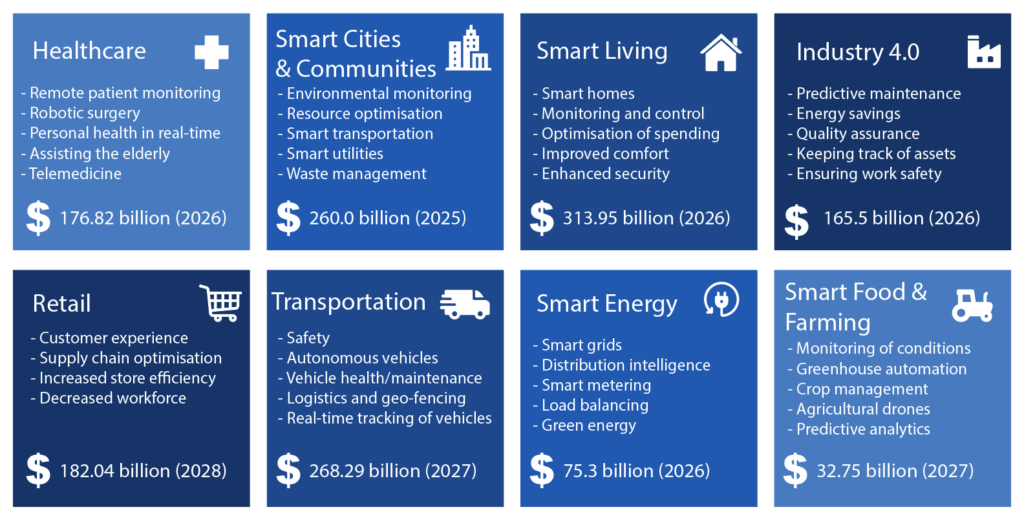
IoT applications also contribute to global green deals and the United Nations’ (UN) sustainable development goals (SDGs) (World Economic Forum, 2018). As recent research by IoT Analytics(2018) shows, 84% of IoT deployments can address SDGs. Most of SDGs address industry, innovation, and infrastructure (25%), smart cities and communities (19%), affordable and clean energy (19%), good health and well-being (7%), and responsible production and consumption (5%) (Lueth 2018). As pointed out in a research paper by Almaki et al. (2021), increasing the number of IoT devices leads to increased energy consumption, but smart solutions in data transmission and design policies can reduce consumption remarkably and thus have a positive net effect on energy and resource efficiency (Almaki et al. 2021).
When IoT solutions or ecosystems are developed (e.g., for the sectors mentioned earlier), they easily become complicated. This is because IoT solutions are built from “modules.” In most solutions, there are several modules, such as hardware, network, connectivity, platform, and end-user application. Usually, one company can offer a solution for one to three modules. Therefore, building IoT solutions requires companies to work together, which also means that profits are distributed among all companies involved.
When IoT solutions are built, cooperation between companies is necessary. Sometimes, this means that new business models need to be developed. As mentioned, the IoT value chain can be quite complicated due to its modular nature. One commonly accepted illustration of the IoT value chain is illustrated in Figure 2.

Figure 2. IoT value chain (Singh 2021).
The IoT value chain is complex and requires more and more adaptive technical solutions. The roles of business actors are different in the IoT value chain than in the typical information and communication technology (ICT) industry, even though the ICT industry has widely adopted the “x-as-a-service” business model. In the IoT value chain, however, there are multiple companies involved in providing value to customers. More complexity in the IoT value chain comes from the fact that there is a need for both general applications that span multiple industries and very narrow, industry-specific applications. When IoT applications are moving toward more user-centric solutions, IoT ecosystems should also be ready to adopt user- and crowd-driven value-creation models. This leads to ecosystem-centric business models wherein product development and innovation processes are not enough for companies to be competitive; innovations are also needed in their business models. Some of the possible roles of companies are presented in Figure 3. These roles are the building blocks of an IoT ecosystem, which contributes, for example, to development, marketing, adoption, and standardization.
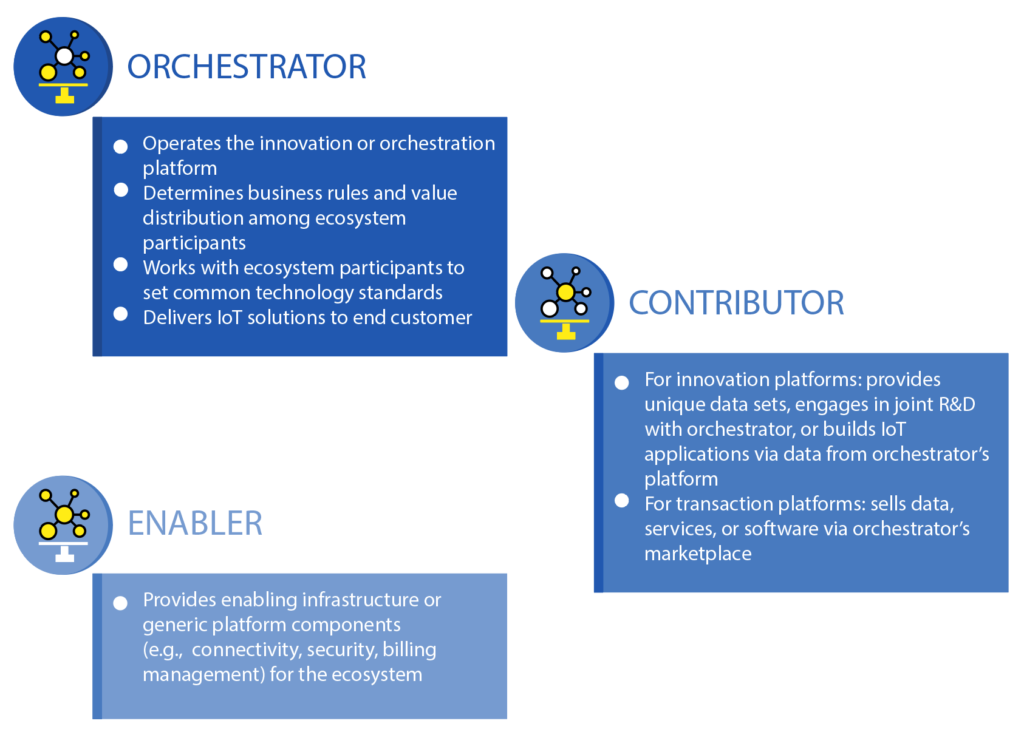
It has been estimated by Statista (2021) that there were over 10 billion IoT devices in 2021, and that number keeps growing fast; by this prediction, there will be over 20 billion IoT devices by 2030 (Statista 2021). Previous research has shown a 15%–30% compounded annual growth rate (CAGR); wide CAGR variation is due to different metrics and methodologies used to calculate the market potential across different research (HIS Markit 2018; Ericsson 2018; Lueth 2020).
The global IoT market value has been estimated to range from US$1 trillion to 1.5 trillion by 2025 (CAGRs 13.6%–22%). Also, geographically, the Asia-Pacific (APAC) region has been recognized as the biggest region in terms of market value, followed by North America and Europe. Africa (EMEA) has been recognized as having the highest relative growth rate. (Bosche et al. 2018; Rishi & Saluja 2019; Lueth 2020)
On the domain side, industrial IoT and smart cities are commonly recognized as the most important domains. Healthcare, smart homes, energy, transportation, and agriculture are also considered to be important domains (Brékine et al. 2020).
How can we reach the next phase of the IoT?
Development of the IoT and its modules (Figure 2) is rapid, and mostly focuses on technological development. However, the development of business support is equally important. The European Union’s (EU) Digital Single Market Strategy (DSMS) is looking to “maximize the growth potential of digital economy” (European Commission 2015). In this context, the development of European competitiveness in the IoT field is of high priority across all sectors. The development of the IoT domain can be seen as crucial for the DSMS. For this purpose, the European Commission launched in 2016 the Digitizing European Industry (DEI) initiative (European Commission 2016). The commission outlined that the IoT represents the next step of disruptive digital innovation where physical and virtual objects are inter-connected to others and to the Internet, these objects can be things or humans (European Commission 2016).
As part of the work in the Horizon-funded Next Generation Internet of Things (NGIoT) project, Europe’s competitiveness in different sectors was inspected and matched to the IoT’s importance in the given industry (Brékine et al. 2020). The results of this research are shown in Figure 4. As seen in this figure, the need for the development of the IoT can be matched to specific sectors to have a high impact. Also, some of the most important sectors regarding the Finnish IoT scheme have been recognized (blue), and sectors with the highest competitiveness development potential have been marked (green). Blue arrows are the authors’ predictions regarding where national IoT research and development (R&D) can take the sectors if development work is performed in association with EU-level R&D work.
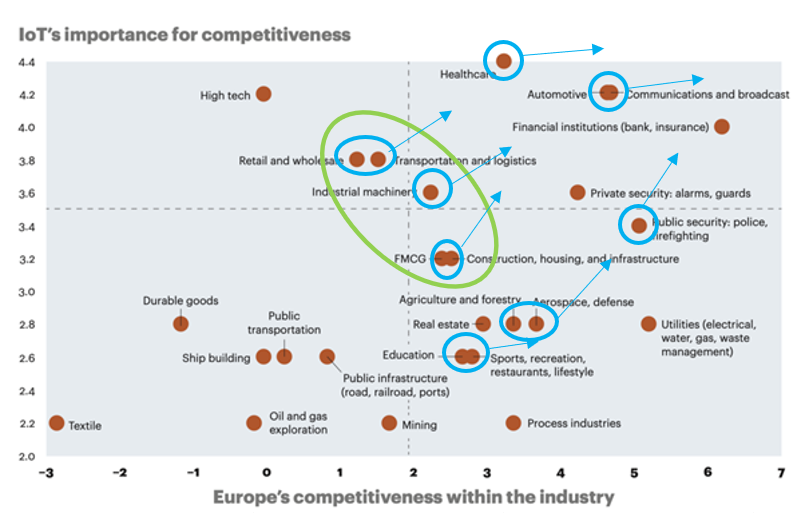
R&D Objectives for IoT Next Phase
To develop the competitiveness of European industry, future development needs to address the following areas: business development, societal development, and technological development. This is necessary because focusing solely on one point of view may lead to either a mismatch between business needs and technology or technology/business discrimination if development is not seen as necessary from society’s point of view. As seen in the previous chapter, this development can address specific sectors to boost Finnish and European competitiveness.
Societal Development
To leverage the full potential of the IoT, input from society and end users is needed; this is also a matter of knowledge sharing. For example, in solutions that aim to support the European Green Deal, cities and communities should be involved in the whole development process of IoT applications.
IoT demystification: Technology companies believe that widespread adoption of the IoT has not yet been achieved. To enable wider use of the IoT, they say it is important to build a new model for user-driven development. Demystification of the IoT should be one of the IoT Next Phase goals, ensuring that new end users, sectors, and applications can be reached. Focusing on services instead of IoT technology might help make its benefits clearer.
End-user-based development: The ability to utilize information is important for the end user. The end user must understand how the data can be utilized and how he or she can develop his or her own business with the help of the collected data. Typically, business streamlining happens either through streamlining existing business processes or by finding new business areas based on IoT technology and data.
The internet of bio things (IoBT): The IoBT is the bridging of biological systems via bioelectronics, offers breakthroughs in fields such as biomedicine that emphasize predictive, preventive, personalized, and participatory (P4) healthcare instead of reactive disease care. The technologies that have become available will offer tools to assemble novel biosensors to advance them toward large data collection via the P4 medicine strategy. Moreover, these emerging tools provide more penetrative bio games, biofeedback-based education, and large-scale natural process censoring for a circular economy. These measures will create new ways for the development of sociobiological ecosystems, contribute to better awareness of the roles of establishments in social dynamics in learning, education, and innovation/business development, and offer cost savings.
Ecosystem thinking for knowledge sharing: Here, the goal is to find ways to teach students about the ecosystem. The aim is to achieve integration between campuses, laboratories, and industry. There is a need for industry interaction between teachers and students to increase entrepreneurship and innovation through strategic partnerships and to build long-term technological visions and business models for universities.
Sustainable development: Digitalization is expected to advance the sustainable development of societies, even if it can also cause risks due to the associated increase in energy consumption, materials used in electronics, or misuse of technology. By being continuously aware of risks, however, their probability can be decreased. Digitalization is certain to create substantial benefits, and IoT technology will play a key role in producing, refining, and sharing data to be utilized by various actors. Through IoT technology, people can continuously receive data from their environment at home, work, or leisure. By receiving data, people can make personal decisions to act in a more sustainable way. They will also receive information about which actions are discouraged, which will result in changes to their behavior. Similarly, businesses can utilize data from various sources to, for example, improve their processes, decrease their energy consumption, or develop digital products and services. In the smart city context, the IoT brings advantages to many sectors, such as mobility, wellbeing, and health services, as well as education and property management, which can be developed to follow sustainability principles by utilizing data (Matinmikko-Blue et al. 2020). Many of the actions that IoT-enabled solutions perform relate to individuals (e.g., through information collection or using this information to make decisions that affect individuals). As the number of IoT devices grows and IoT solutions move closer to our daily lives, it is important to act toward creating a responsible IoT system. One approach is to adopt digital responsibility goals (DRGs).
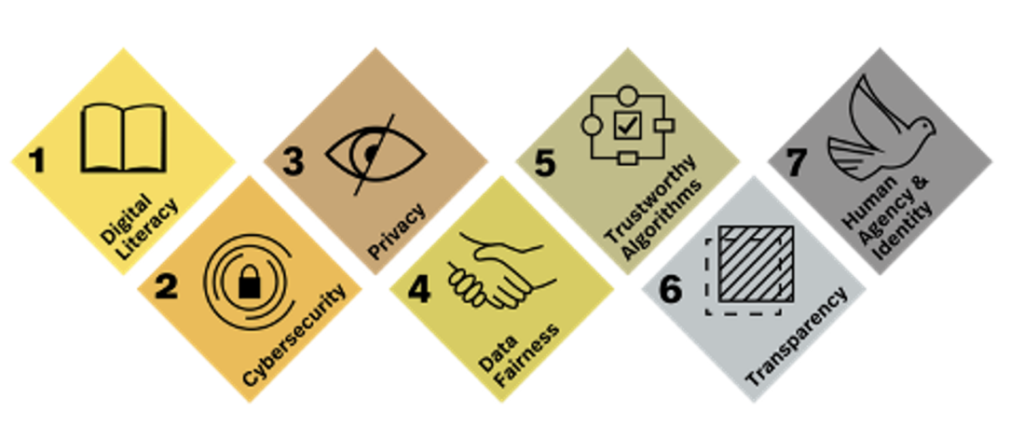
In Figure 5, the DGRs are illustrated. Once a company adopts these goals, it makes a commitment to the following:
A) Implementing up-to-date cybersecurity in all components and parts of the process
B) Taking privacy into account at the point of data collection
C) Adopting data fairness, even when not handling personal data
D) Processing data with the goal of trustworthiness
E) Proactively creating transparency for users and all other stakeholders about the principles that underlie their digital offerings
(Meier et al. 2021)
With these commitments, companies can build a sustainable IoT and other digital systems. However, how these can be applied in practice is something that future R&D will/can define.
Table 1. Suggested R&D objectives and actions
| Societal Development | ||
| Objective | Timespan | Actions |
| IoT-specific knowledge sharing | 0-5 years | – Perform IoT knowledge sharing in workshops with larger audiences, and using open IoT solutions – Help companies understand the benefits of the IoT—how the IoT is already transforming customer experience, operations, and business models – Integrate IoT technology into companies’ technology stacks and roadmaps trough rapid/agile pilots |
| User-centric IoT | 0-3 years | – Create local IoT workspaces to promote the advantages of the IoT and its use cases – Engage individuals and citizens in the development of everyday IoT solutions, focusing on health, wellbeing, and smart living |
| Trustworthy IoT | 0-5 years | – Build transparency regarding data usage, and create trustworthy data processing – Ensure the ability to use and design IoT solutions securely – Develop common technologies that meet current/future privacy requirements (e.g., privacy by design, GDPR, DGA) |
| Responsible IoT | 0-7 years | – Recycle IoT devices – Perform a thorough ethical evaluation of the value chain – Develop open-IoT architectures and services – Create transparent data usage/integration models |
| IoBT (IoT of bio things) | 0-7 years | – Large adoption of biosensors for wellbeing |
Business Development
As a rich source of valuable data, new IoT solutions (Table 2.) will serve as the baseline for new revenue and business models in Industry 4.0.
The data economy: Companies need to understand the future of the data economy and how it will be applied in their own businesses. In the new economy, new approaches to producing and consuming data should be invented. To support this, legislative initiatives in the European Union (EU) are currently in progress. The Data Governance Act (DGA) has recently been approved, and data service-related acts (e.g., DMA, DSA) are under intensive discussion in 2022.
Also, the EU’s Data Act (DA), Cyber Resilience Act, and the forthcoming regulations within the digital finance package will boost not only the European data-sharing economy, but also emerging businesses in data analytics and other added-value services within the open data environment. At the same time, specifications of the European data space are promoted by the Data Space Business Alliance (DSBA), and their activities are expected to yield initial specifications soon, which will then lead to the first reference implementations in the data marketplace in 2023–2024.
All of this will require intensive monitoring of this evolving data space by all actors. Data generated by IoT systems will also receive a new level of added value and even become objects for trading. The multiplicative effects in technological development, IoT platforms, business models, and new services will be substantial. Thus, R&D activities across the whole new value chain must be intensified considerably. This should also have consequences for education, especially regarding the sharing of information and knowledge transfer that occurs in higher education and research institutes. Furthermore, the data economy will introduce new business and revenue models for its participating companies, which may require the discovery of new resourcing and funding models, especially for SMEs to survive in a changing environment.
Ecosystem thinking: In an ecosystem, each stakeholder must define its motivation and justification to act as part of the ecosystem. End-user companies may not have the ability to start building IoT-based intelligence for their own business applications. They need to develop their knowledge to identify trusted technology vendors to build their systems and understand the needs of their companies. End users need an accessible network with the ability to implement a customized system to support the company’s business.
Data ownership: The system vendor must understand the customer’s interest in data ownership. Issues regarding data ownership in the customer’s data system need to be discussed and agreed upon during the system construction phase so that the value of the collected data does not fall into the wrong hands.
Table 2. Suggested R&D objectives and actions
| Business Development | ||
| Objective | Timespan | Actions |
| Development of IoT data economy | 0–5 years | – Sharing knowledge about the data economy and its possibilities – Development of new IoT-related business models – Development of data-sharing models – Development of value-sharing models – Establishing data markets for IoT (architectures & solutions) |
| Support for SMEs in IoT implementations | 0–3 years | – Easy-to-deploy IoT solutions for rapid piloting – Open knowledge sharing through communities and workshops – Transparent overall pricing in cloud systems/IoT services – Expert support from academics/other companies |
Technological Development
IoT is a technological composite that combines different areas of the ICT industry, so development of technological solutions is highly crucial for a larger IoT uptake (Table 3.). The IoT integrates innovations in sensors, telecommunications, data processing, and platforms. The utilization of IoT solutions usually involves the need to tailor technologies vertically and, sometimes, company-specifically. In some applications, sensor energy savings, reliability, and efficiency are decision-making factors, while real-time data analysis at the sensor level and autonomy may be important factors in other applications.
Real-time data transfer requirements contribute to the architecture of IoT networks with distributed data processing alongside centralized cloud solutions. In 5G and beyond-5G technologies, real-time and machine type communication (MTC) requirements have been considered for use in radio technologies and architecture.
The benefit of the IoT is data-driven decision making and management. The raw data needs to be processed into an easily understandable format, such as real-time charts and graphs, to support better decision making in businesses. One technological barrier large-scale adoption of IoT is the lack of interoperability. IoT systems typically include components (e.g., sensors, gateways, cloud services, and applications) from different vendors. Reliable systems demand seamless operation between these components regarding both data and connectivity compatibility. Open industry standards are seen as one of the targets for IoT Next Phase to increase the scalability and stability of IoT networks and their cost efficiency.
In IoT systems, massive amounts of data are gathered from various sources and locations. Making access to the collected data easy and making its format heterogeneous enables the scalability of the IoT. From this point of view, new data management methods are needed. The development of new data management methods must be closely connected with ongoing specification work by the DSBA and involve major actors (e.g., Gaia-X and the IDSA) to work toward common reference architecture and specification for European data spaces. Also, the validation and certification of data marketplaces is an important part of the development work. R&D organizations must also be at the forefront of applying, testing, and building reference implementations for IoT data.
The nature of the IoT, where there are massive amounts of often weakly-protected devices, makes it vulnerable and offers a large surface for attacks. Security and privacy issues need to be carefully addressed during the design phase, especially for critical applications. Trust is an essential aspect of human interactions with IoT-enabled services.
The tactile internet is an internet network that combines ultra-low latency with extremely high availability, reliability, and security (Shashikala & Varsha, 2017). It will enable haptic interaction with visual feedback in real-time interactive systems, encompassing human-to-machine and machine-to-machine interactions. The tactile internet will enable humans and machines to interact with their environments in real time.
The amount of data generated by IoT sensors is huge, and artificial intelligence (AI) is needed to find meaningful changes in the data. AI can well help in managing and maintaining the system and securing systems. AI can also be used to find patterns in data that can be used for predicting future events, such as machine failures. Also, AI is the key component in real-time decision making and autonomous IoT solutions.
Digital twin applications help humans perceive IoT systems and interact with them more easily. The IoT is not just a type of machine to machine (M2M) communication; an increasing number of applications require interaction and decision making together with humans. The data received from the digital twin must be processed in real time to support decision making process.
A distributed ledger is a database containing any transactions or contracts that are shared and synchronized across several locations or among multiple participants. It is decentralized to eliminate the need for a central authority to process, validate, or authenticate the transactions, and it is less prone to cyberattacks or fraud because any changes are distributed to all participants immediately.
Table 3. Suggested R&D objectives and actions
| Technology Development | ||
| Objective | Timespan | Actions |
| Future IoT networks | 0-7 years | – Creation of reliable, low-cost, sustainable, and scalable IoT networks – Convergence of IoT and mobile technologies (e.g., 5G/6G/low-power networks) – Development of peer to peer (P2P) communications between devices – Development of multi-access and multi-radio connectivity – Self-powered IoT network devices |
| Next generation IoT architectures | 0-5 years | – Realtime data processing in edge servers and/or devices – Autonomous and use-case specific IoT devices – Distribution of task intelligence between cloud, edge, and device – Adaptive and reconfigurable architectures – Future-proof security through architectures – Super-integration of the IoT |
| Interoperability and data sharing | 0-3 years | – Participation in and contribution to standardization and platform development (e.g., IETF and Gaia-x) |
| Realtime human-to-machine interaction | 0-5 years | – Development of low latency interactions and user interfaces between user and device – Integration between IoT systems and AR / VR / XR solutions – User- and use-case centric visualization of data compositions |
| Tracking in IoT applications | 0-3 years | – Seamless positioning in outdoors, indoors, and in between |
Conclusion
It is hard to estimate how much will be spent on IoT solutions during the next 5–10 years. Some estimations have arrived at nearly US$6 trillion during the next five years. With IoT solutions, companies and organizations are looking at lower operating costs, increased productivity, and the development of new products through the IoT. All of this will accelerate the future development of the IoT. The development in IoT Next Phase will happen on multiple different levels, including business, societal, and technological development.
In the future, the IoT will be more user- and use-case centric in the development stage and in its data collection and data usage. This means that IoT devices will be more focused on specific use cases. Also, applications and their features (e.g., AI and data processing) will move closer to the usage point. This development will cause existing cloud-heavy solutions to switch to more device-oriented solutions. As devices are more responsible for data processing and decision making, they will also need to transfer the data faster and with lower latency. This means that the devices will be more dependent on other devices and edge nodes. All this will lead to a new overall IoT architecture (Figure 6).
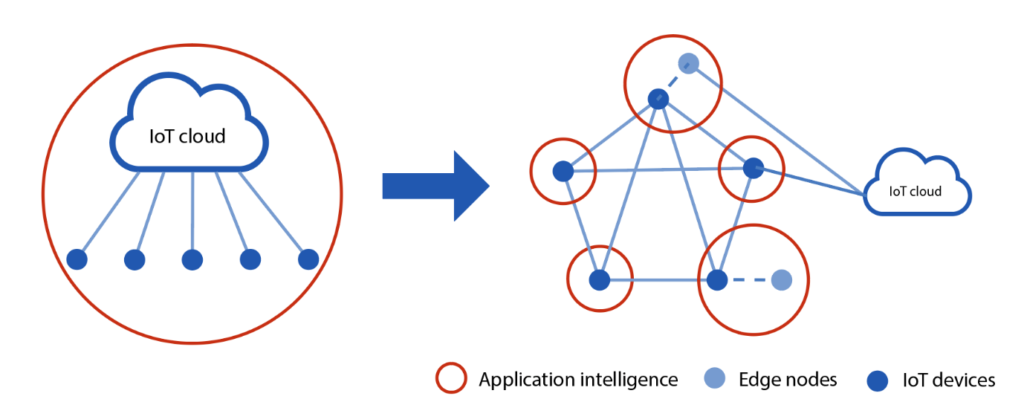
As we move toward a sustainable world, the IoT also needs to be both greener and more sustainable in the future. This can be achieved either through achieving a high recycling rate or by making IoT devices sustainable while using new electronics. Sustainability also challenges the ways in which we collect and process data in IoT ecosystems. End users are increasingly aware of their data privacy, but in the future, they will also require that data be processed and stored in a fair, transparent, and trustworthy way. When more data is processed, it requires more energy, so developers of IoT applications need to be aware of their role in sustainability.
The next phase of the IoT requires research, development, and go-to-market actions (as defined in the previous chapter’s tables). These actions can be funded by either national or European instruments. By leveraging funding possibilities, Finnish companies and organizations can achieve competitiveness and an increase in their value through the IoT, as estimated in Figure 7. The figure graphically illustrates the actions that are needed, and their possible funding instruments.

References:
Almaki, F. et al. 2021. Green IoT for Eco-Friendly and Sustainable Smart Cities: Future Directions and Opportunities. Mobile Networks and Applications. 2021. Available at: https://doi.org/10.1007/s11036-021-01790-w. Accessed 14 Nov 2021.
Bosche A. et al. 2018. Unlocking Opportunities in the Internet of Things. Available at: https://www.bain.com/insights/unlocking-opportunities-in-the-internet-of-things/. Accessed 4 Dec 2021.
Brékine, A. et al. 2020. IoT research, innovation and deployment priorities in the EU White Paper. Available at: https://www.ngiot.eu/wp-content/uploads/sites/73/2020/09/D3.1.pdf. Accessed 4 Dec 2021.
Ericsson 2018. Ericsson Mobility Report. Stockholm: Ericsson.
European Commission, 2016. Digitising European Industry – Reaping the full benefits of a Digital Single Market, Brussels: European Commission.
European Commission, 2016. Advancing the Internet of Things in Europe (2016), Brussels: European Commission.
European Commission 2015. A Digital Single Market Strategy for Europe, Brussels: European Commission.
HIS Markit 2018. 8 in 2018: The top transformative technologies to watch this year. London: HIS Markit.
International Telecommunication Union (ITU) 2018. Security framework for the Internet of things based on the gateway model. Available at: https://www.itu.int/itu-t/recommendations/rec.aspx?id=13607. Accessed Nov 2021.
Lueth K. 2018. The Effect of the Internet of Things on Sustainability. Available at: https://iot-analytics.com/effect-iot-sustainability/. Accessed 15 Nov 2021.
Lueth K. 2020. State of the IoT 2020: 12 billion IoT connections, surpassing non-IoT for the first time. Available at: https://iot-analytics.com/state-of-the-iot-2020-12-billion-iot-connections-surpassing-non-iot-for-the-first-time/. Accessed 15 Nov 2021.
Massimo R. & Wang G. 2020. Orchestrating the Value in IoT Platform-Based Business Models. Available at: 2020, https://www.bcg.com/publications/2020/value-in-iot-platform-based-business-models. Accessed 12 Dec 2021.
Matinmikko-Blue, M. et al. 2020. White paper on 6G drivers and the UN SDGs, Oulu: University of Oulu.
Meier, J. et al. 2021. Digital responsibility goals letter EU Commission, Brussels: Identity Valley.
Rahul R. & Saluja R. 2019. Future of IoT. Jaipur: Federation of Indian Chambers of Commerce and Industry. Available at: 2020, https://ficci.in/spdocument/23092/Future-of-IoT.pdf. Accessed 12 Dec 2021.
Singh V. 2021. IoT Companies: 5 Players Leading the Market. Available at: https://www.greyb.com/iot-companies/. Accessed 1 Dec 2021.
Shashikala, H. S. & Varsha, K. P. 2017. The tactile Internet. 2017 International Conference on Innovative Mechanisms for Industry Applications (ICIMIA), pp. 419-422.
Statista 2021. Number of Internet of Things (IoT) connected devices worldwide from 2019 to 2030. Available at: https://www.statista.com/statistics/1183457/iot-connected-devices-worldwide/. Accessed 17 Nov 2021.
World Economic Forum 2018. The effect of the Internet of Things on sustainability. Available at: https://www.weforum.org/agenda/2018/01/effect-technology-sustainability-sdgs-internet-things-iot/. Accessed 3 Nov 2021.
Jari Isohanni
Head of ICT Degree Programme
Centria University of Applied Sciences
Tel. +358 40 669 0690
Marjo Heikkilä
Head of Digitalization Team
Centria University of Applied Sciences
Tel. +358 44 449 2507
Virve Malkamo
RDI Specialist
Centria University of Applied Sciences
Tel. +358 40 183 2723
Mikko Himanka
Lecturer, Project Manager
Centria University of Applied Sciences
Tel. +358 44 449 2537
Risto Jurva
Program Manager
University of Oulu
Tel. +358 50 470 1351
Contributing experts:
University of Oulu:
Jaakko Sauvola, Professor
Pirkko Taskinen, Director of OIA Water Ecosystem and SuperIoT DIH
LUT University:
Sami Hyrynsalmi, Associate Professor (tenure track)
Pedro Nardelli, Associate Professor (tenure track) / LUT University; Docent / University of Oulu

